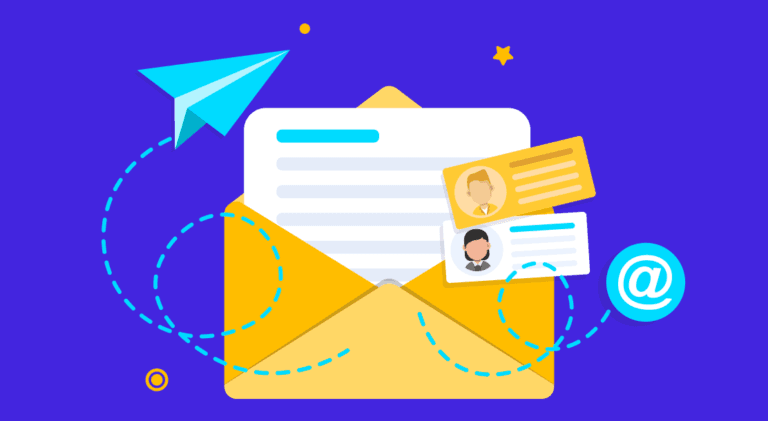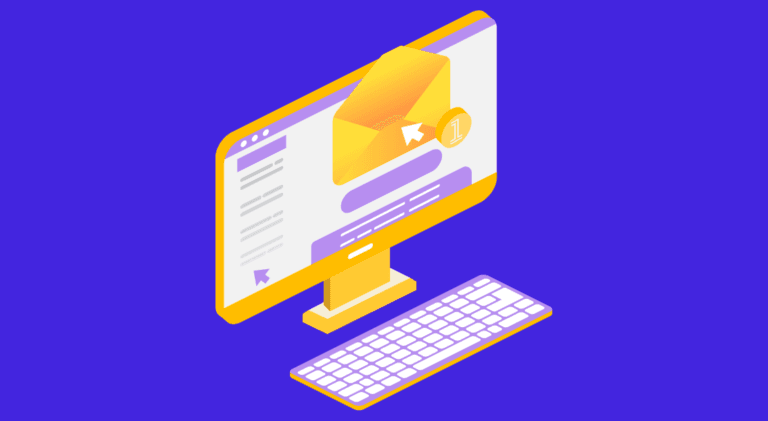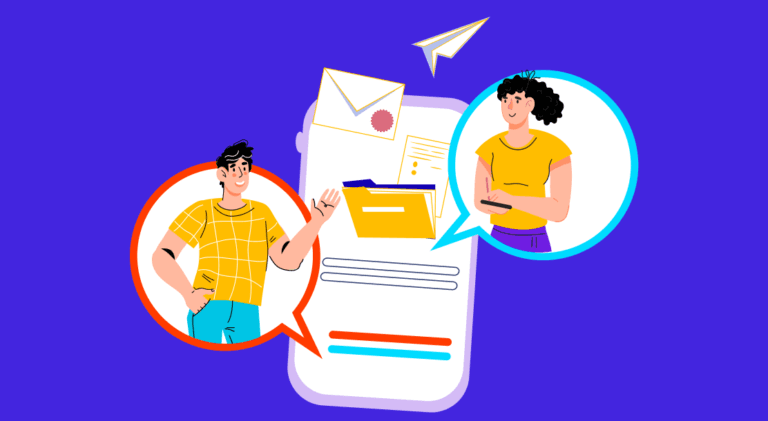
Table of Contents
- The Need for Follow-up Emails
- How to Write Follow-up Emails
- 5 Mistakes People Make with Follow-up Emails
- Key Takeaways
- Conclusion
- FAQs
Follow-up emails are a rather important step in your content marketing strategy. Sometimes (more often than not), a business may not receive responses from its clients for various reasons. The content may be ineffective or the email tone may be off, or the client may just not be interested. Nevertheless, it is up to the business to send follow-up emails to make sure the message gets across.
Before we give you follow-up email tips, let’s first understand when and why follow-up emails are important.
Follow-up emails are often sent on occasions such as after meeting a prospective client or investor at an event, after sharing an invoice, or after sending the first round of mail but receiving no response. Follow-up emails are used to improve sales, close deals, or get the data you want.

The Need for Follow-up Emails
Sales representatives in all cases concur that follow-up is a crucial piece of the business cycle, yet the question of how and when to do so is often debatable. In a world that is trying to restrict our capacities to focus (and succeeding), following up has never been more significant. All it takes is one day for an email to be ancient history. In this way, not following up basically because you would rather not trouble the recipient is doing more harm than good to your business.
Here are five reasons to send that pending follow-up email.
1. Establishes relationships
Since you need to build associations with potential customers and guarantee they know what’s happening with your business, you need to reach them on a standard premise. If not, it’s difficult for them to remember your business and continue to band together with another. One method for reinforcing your relationship with a customer is by guaranteeing that the subsequent follow-ups you send are connected with the previous ones.
2. Builds trust
Follow-up emails show that you trust your client to interact with your brand. By giving it a second thought, your make sure your client knows that you trust them to become a loyal customer.
3. Improves conversion rates
There are many benefits of sending a follow-up email; making sales is one of the biggest. Individuals are occupied, or your email might be lost in an inbox among many different messages. A follow-up email is a method of adding esteem and helping your clients in each progression of the buyer’s dealing.
4. Onboards potential clients
Follow-up emails are generally imperative for sales and marketing departments attempting to bring in new clients. How you connect and interact with potential clients is what keeps your business apart from the competition. Use follow-up emails to build an affinity with clients and address any worries.
5. Is customizable
The more customized an email is, the more recipients react to it. Customized mails undeniably get more attention than mails that are not customized. Personalization adds to client experience as well.
Now that you have understood the importance of follow-up emails let us help you with writing a successful mailer.
How to Write Follow-up Emails
Here is a 6-level check to avoid any follow-up email mistakes:
1. Perfect the headline
Create an ideal headline while setting up your subsequent follow-ups. The headline is the first thing your prospective clients see, and they might choose whether to peruse your mails, depending on just that. Try writing follow-up mail phrases such as “simply checking in” as the headline to make it more pleasant, and compose an appealing copy that makes clients open your email.

2. Begin with an alluring first line
If you start your mail with a cold, dull, and non-customized first line, the odds are that you’ll never get a response from your clients. You can start by showing interest in an inquiry, noticing common associations, or beginning with the client’s concern. Other than that, attempt to give the reason for why you’re mailing them in the first few lines. It could very well be a basic and short recap of your previous email.
3. Keep it straightforward
Send a follow-up email with content that is short and to the point.
4. Personalization is the key
Personalization is fundamental with regard to sending an effective email follow-up. The more relevant your follow-up, the better your reaction rate. It is challenging to personalize every single email – so use tools to automate an entire cycle for greater impact.
5. Avoid hostilities
Direct aggression is somewhat simple to recognize. More discreet passive-aggressive expressions that can slip into your follow-ups nearly without a thought are more dangerous. Such negligible hostilities can annoy your clients and adversely impact the generosity and all the shared trust you have set up.
6. Place call-to-action buttons towards the end
When you send a follow-up mail, be extremely clear with what you want to accomplish with it. CTA is super significant here.
5 Mistakes People Make with Follow-up Emails
1. Not following up at all
Unexpectedly, one of the greatest follow-up email mistakes you can make as a sales representative is essentially not doing it at all. Despite any possible justifications, this is a mistake.
Fix: To cut through the noise, sending a follow-up email after a meeting is essential to connect with your clients. A handy spreadsheet is a simple, low-tech answer for monitoring follow-ups. Regardless of whether you use Microsoft Excel, Google Sheets, or Apple Numbers, make a sheet with segments for the date, contact name, favored strategy for correspondence, last follow-up date, status, and extra notes.
2. Beginning with words like “follow-up.”
Most people who create a follow-up email would imagine that the headline should be “follow-up.” While it may be logical, it lacks consideration. The client gets no advantage from the subject line. They will be baffled by the email. Furthermore, it seems like you’re asking the person not to react. That is rarely compelling.
Fix: Create a subject line appropriate to the email’s objective. Think about the reason for the email. Individuals are occupied and may not have the time to read between the lines since you didn’t simplify it for them either. Thus, use the subject line to make the communication smarter, give them options or disclose how you expect them to react.
3. Not customizing the content
No one prefers repetitive, templated answers. While your mechanized email formats may be fruitful once, keeping a solitary tone in your subsequent follow-ups will just lead your clients to unsubscribe.
Fix: Be sure that you use impartial humor that isn’t hostile or improper. Using an entertaining, conversational tone in messages can be a significant difference between getting a reaction and getting ghosted.
4. Improper research
Research your clients (hopefully once again) before sending them follow-up emails.
Fix: The more you research the better. Head over to your target audience’s social media or website to gather information on their interests and activities. Use it at the start of the communication to get a sureshot reaction.
5. Not featuring the CTA
When composing a pleasant, subsequent email, the last and most common error is neglecting telling your client what to do next.
Fix: When composing a follow-up email, be clear about what you need the individual to do with the email you’ve sent. Do you need them to reply to you? Fill in a form? Visit your website? Be clear and explicit, so that they know what you need them to do.
Key Takeaways
- It usually takes about twelve follow-up emails before customers react to an email.
- Writing great follow-up emails isn’t difficult. Just be accurate and write pleasing, precise content.
- Ensure you test all your emails before they are sent out.
- Consider sending a follow-up emails within 3 days of the previous one.
- Tools like MailChimp assist you with email marketing and help you track its performance.
Conclusion
Follow-up emails are, by a wide margin, the best way to interact with clients and convert them. But on the other hand, they’re the most ignored. Sending out few or no follow-up emails will affect your business. The best follow-up emails are the ones sent reliably on the second, third, and fourth attempts. Give these follow-up email tips a shot and see how your business soars.

FAQs
Be affable and inquire whether your client has seen your previous email. Offer them all the information they need to know along with a clear CTA.
You could attempt follow-up email phrases like “Just checking on this (request/question/task).”
Email communication is prompt and receives quick reactions. Follow-up emails convey to clients that they are important to a business.
Spelling and language structure errors are a big no-no in any sort of content. And follow-up emails are no different. Properly edit, proofread and test your emails before sending them out.
Latest Blogs
Explore how Google’s 2025 AI search updates triggered ranking chaos. Learn actionable strategies to adapt your SEO for AI Overviews, zero-click searches, and SERP volatility. Stay ahead now.
Learn how to rank on AI search engines like ChatGPT, Perplexity, and Gemini by optimizing your content for authority, structure, and relevance. Stay ahead in AI-driven search with this strategic guide.
Explore the best healthcare SEO services for your medical practice. Improve online visibility and effectively reach more patients in need of your services.
Get your hands on the latest news!
Similar Posts

Email Marketing
6 mins read
11 Tips to Design Impactful Email Banners

Design
9 mins read
7 Benefits of a Simple Mailer Design

Email Marketing
7 mins read